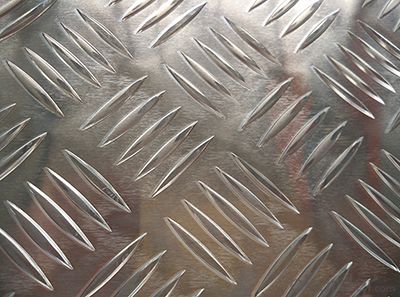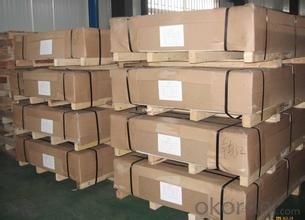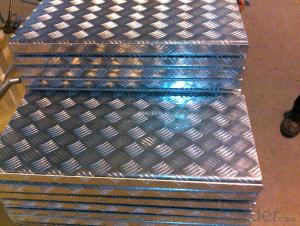Small Five Bar Treadplate for making car flooring
- Loading Port:
- Shanghai
- Payment Terms:
- TT OR LC
- Min Order Qty:
- 5 m.t.
- Supply Capability:
- 1000 m.t./month
OKorder Service Pledge
OKorder Financial Service
You Might Also Like
Item specifice
1. Structure of Small Five Bar Treadplate for making car flooring
CC Aluminium sheet for making trailer is one semi-finished aluminium material. This sheet can be cut to size you wanted in production. The alloy AA1050 is widly used in building, industry ect. Its weight is much lower than steel. So many customers choosed aluminium material instead of steel.
2. Specification of Small Five Bar Treadplate for making car flooring
Aluminum Coil/Sheet | |
Main Specification | |
Alloy | AA1xxx (AA1050, AA1060, AA1070, AA1100 etc.) |
AA3xxx (AA3003, AA3004, AA3005, AA3105 etc.) | |
AA5xxx, AA6XXX (AA5052,AA5083, AA5754, AA6061, AA6062 etc.) | |
AA8xxx(AA8011, AA8006 etc.) | |
Temper | H14,H16, H18, H22, H24, H26, H32,O/F, T4, T6, T651 |
Thickmess | 0.01mm-100mm |
Width | 30mm-1700mm |
Standard | GB/T 3880-2006/ASTM |
Special specification is available on customer's requirement | |
3. Application of Small Five Bar Treadplate for making car flooring
(1).Interior: wall cladding, ceilings, bathrooms, kitchens and balconies, shutters, doors...
(2).Exterior: wall cladding, facades, roofing, canopies, tunnels,column covers , renovations...
(3).Advertisement: display platforms, signboards, fascia, shop fronts...
4. Feature of Small Five Bar Treadplate for making car flooring
Surfact Quality :
Be free from Oil Stain, Dent, Inclusion, Scratches, Stain, Oxide Dicoloration, Breaks, Corrosion, Roll Marks, Dirt Streaks and other defect which will interfere with use,
Mechenical Property:
Chemical Composite and Mechanical Property
5. Certificate of Small Five Bar Treadplate for making car flooring
SGS and ROHS(if client request, paid by client), MTC(plant provided), Certificate of Origin(FORM A, FORM E, CO), Bureau Veritas and SGS (if client request, paid by client), CIQS certificate
6. Image of Small Five Bar Treadplate for making car flooring



7. Package and shipping of Small Five Bar Treadplate for making car flooring
First, plastic cloth with drying agent inside; Second, Pearl Wool ; Third, wooden cases with dry agent , fumigation wooden pallets, aluminum surface could cover blue PVC film
8. FAQ
1) What is the delivery time?
Depends on actual order, around 20 to 35 days
2) What is the QC system:
We have QC staff of 20 persons and advanced equipment, each production is with MTC traced from Aluminum ingot lot.
3) What market do you mainly sell to?
Australia, America, Asia, Middle East, Western Europe, Africa etc
- Q:What is the difference between the alloy 1060H24 aluminum plate and the alloy 1100H24 aluminum plate?
- In all series, the 1000 series belongs to a series with the largest amount of aluminum. Purity can reach more than 99%. Because it does not contain other technical elements, the production process is relatively simple, and the price is relatively cheap. It is the most commonly used series in the conventional industries.
- Q:Can aluminum sheets be painted?
- Yes, aluminum sheets can be painted. However, the process of painting aluminum sheets may require some preparation to ensure proper adhesion and durability of the paint. The most important step is to clean the surface of the aluminum sheet thoroughly to remove any dirt, grease, or corrosion. This can be done using a mild detergent and water or a specialized aluminum cleaner. After cleaning, the surface should be dried completely before painting. To improve the paint adhesion, it is recommended to apply a primer specifically designed for use on aluminum. The primer will create a bond between the aluminum surface and the paint, ensuring better adhesion and longevity of the paint job. After the primer has dried, a suitable paint can be applied to the aluminum sheet. It is important to choose a paint that is compatible with aluminum and provides good adhesion and weather resistance. Acrylic or epoxy-based paints are commonly used for painting aluminum. Before painting, it is advisable to test a small inconspicuous area to ensure that the paint adheres properly and achieves the desired finish. Additionally, it is important to follow the manufacturer's instructions for the specific paint and primer being used, including proper drying times and application techniques. Overall, while aluminum sheets can be painted, it is essential to properly prepare the surface, use suitable primer and paint, and follow the recommended procedures to achieve a durable and aesthetically pleasing paint finish.
- Q:Can aluminum sheets be used for wall cladding?
- Indeed, wall cladding can utilize aluminum sheets. The lightweight quality, durability, and resistance to corrosion make aluminum a favored option for cladding materials. It is frequently employed in both commercial and residential constructions to enhance the external appearance of a structure with an appealing and contemporary aesthetic. The malleability and ease of fabrication of aluminum sheets enable the creation of diverse shapes and sizes, facilitating flexible design possibilities. Furthermore, aluminum cladding demands minimal maintenance, necessitating only sporadic cleaning and upkeep. In summary, aluminum sheets are a versatile and pragmatic selection for wall cladding.
- Q:What is the thickness range available for 101 aluminum sheets?
- The thickness of 101 aluminum sheets can differ depending on the manufacturer and supplier. Typically, these sheets come in various thicknesses, ranging from 0.016 inches (0.41 mm) to 0.25 inches (6.35 mm). It is crucial to mention that this range does not encompass all possibilities, as there might be alternative thickness options or customizable choices depending on specific needs or preferences.
- Q:Aluminium magnesium alloy plate, 5052 aluminium plate, 5005 aluminium plate. 5252 aluminum plate performance and use
- Electronic cabinet material and LED LCD TV backlight board
- Q:Can the aluminum sheets be used for manufacturing food storage containers?
- Yes, aluminum sheets can be used for manufacturing food storage containers. Aluminum is a highly suitable material for food storage due to its non-toxic properties, excellent heat conductivity, and resistance to corrosion.
- Q:Can aluminum sheets be easily formed or bent?
- Yes, aluminum sheets can be easily formed or bent due to their high malleability and low density.
- Q:What are the different bending methods for aluminum sheets?
- Aluminum sheets can be bent using different methods, each with its own advantages and limitations. Various bending techniques for aluminum sheets include: 1. Air Bending: By utilizing a punch and die, a bend is formed in the aluminum sheet without direct contact. Compressed air is employed to exert force on the sheet, resulting in the desired bend. Air bending is a versatile method that allows for a range of bend angles and radii. 2. Bottom Bending: This method involves clamping the aluminum sheet between a V-shaped die and a flat die. A punch is then used to press the sheet into the V-shaped die, creating the desired bend. Bottom bending is suitable for achieving sharp bends with small radii. 3. Coining: Precise and crisp bends are formed by applying high pressure to the aluminum sheet between a punch and a die. Coined bends exhibit minimal springback. However, this method requires specialized equipment and is typically utilized for high-volume production. 4. Roll Bending: By passing the aluminum sheet between a set of rollers, it is gradually bent into the desired shape. Roll bending is commonly employed for creating cylindrical or conical shapes. This technique can achieve large radii and is suitable for thicker aluminum sheets. 5. Press Brake Bending: This commonly used method employs a hydraulic or mechanical press brake to create bends in aluminum sheets. The sheet is clamped between a punch and a die, and the press brake applies force to create the bend. Press brake bending offers flexibility in terms of bend angles and radii. It is important to consider various factors such as the desired bend angle, radius, material thickness, and specific application requirements when selecting a bending method.
- Q:Are 101 aluminum sheets suitable for chemical processing environments?
- Yes, 101 aluminum sheets are suitable for chemical processing environments. 101 aluminum is a commercially pure aluminum alloy that offers good corrosion resistance and excellent weldability. It is often used in applications where high corrosion resistance is required, such as chemical processing plants. Additionally, 101 aluminum sheets can be further protected by applying a protective coating or anodizing process, which enhances their resistance to chemicals. Overall, 101 aluminum sheets are a suitable choice for chemical processing environments due to their corrosion resistance and ability to withstand exposure to various chemicals.
- Q:Can aluminum sheet be used for architectural applications?
- Yes, aluminum sheet can be used for architectural applications. It is a versatile material that offers durability, lightweight properties, and corrosion resistance, making it suitable for various architectural projects such as facades, roofing, window frames, and decorative elements. Additionally, aluminum can be easily formed, fabricated, and finished to meet specific design requirements, making it a popular choice in the construction industry.
1. Manufacturer Overview |
|
|---|---|
| Location | |
| Year Established | |
| Annual Output Value | |
| Main Markets | |
| Company Certifications | |
2. Manufacturer Certificates |
|
|---|---|
| a) Certification Name | |
| Range | |
| Reference | |
| Validity Period | |
3. Manufacturer Capability |
|
|---|---|
| a)Trade Capacity | |
| Nearest Port | |
| Export Percentage | |
| No.of Employees in Trade Department | |
| Language Spoken: | |
| b)Factory Information | |
| Factory Size: | |
| No. of Production Lines | |
| Contract Manufacturing | |
| Product Price Range | |
Send your message to us
Small Five Bar Treadplate for making car flooring
- Loading Port:
- Shanghai
- Payment Terms:
- TT OR LC
- Min Order Qty:
- 5 m.t.
- Supply Capability:
- 1000 m.t./month
OKorder Service Pledge
OKorder Financial Service
Similar products
New products
Hot products
Related keywords































